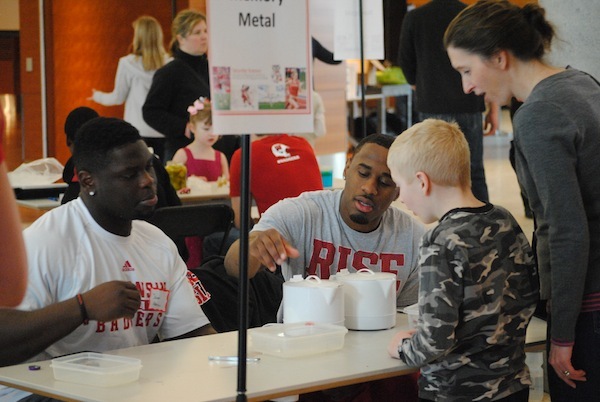For athletes, Beyond the Game opens doors to science

A young visitor to the Wisconsin Institutes for Discovery’s Science Saturday is wowed by a demonstration of shape-memory alloys, which can “remember” shapes they are put in even after being straightened under exposure to hot temperatures. James Adeyanju (left) and Devin Gaulden, both members of the Badger football team, were among dozens of UW–Madison athletes who volunteered at the event.
Badger football player Melvin Gordon knows something about testing the laws of physics.
On a football Saturday, Gordon, a star running back, can be seen squeezing through an impossibly small hole for a first down, or launching himself into the end zone with a gravity-defying leap.
Earlier this month, despite the football season having ended exactly a month before, Gordon once again had a horde of red-clad fans in awe.
With electrocardiogram diodes attached to his arm, Gordon squeezed a metal handle. As he tightened his grip, a computer tracked the electricity moving through his heart. His results were off the charts compared with the rest of the day’s participants.
“He needs that grip if he doesn’t want to fumble,” LaVar J. Charleston explained to a gathering of people watching the display. “He’s got to hold on to the ball.”
Charleston, assistant director of Wisconsin’s Equity and Inclusion Laboratory (Wei LAB), is a contributor and instructor for the Beyond the Game initiative. The program featured in the Wisconsin Institutes for Discovery’s Science Saturday event on Feb. 1, focusing on the science of Badger athletics.
A majority of the 35 athletes involved in the program participated in the event, a hands-on science fair open to the public, featuring dozens of interactive experiments.
“I didn’t persist in STEM because I didn’t have the support I needed to be successful. So I want to make certain they have all of the encouragement and support they need to complete their degrees.”
LaVar J. Charleson
“We encourage the student-athletes involved in [Beyond the Game] to engage in activities outside of their sport,” Charleston says. “Community involvement is a big part of our program and the Wisconsin Idea, and the fact that this event features science is even better, because there’s a falsehood that athletes have no interest or ability to do science.”
Created in 2010 by the Wei LAB and implemented in 2011 by the university’s Office of Academic Services in the athletic department, the program entails classes, seminars, and a practicum experience. Its primary goal is to improve graduation rates and post-graduate outcomes of student athletes.
Charleston, who helped design the program’s curriculum and who teaches several of its core classes, says the program includes a diverse body of student-athletes. But it is especially geared toward aiding African-American male student-athletes achieve their academic potential.
“The program exists to help these students realize their potential outside of athletics,” he says. “We want to open their eyes to the fact that, at some point, their athletic careers will end.”
A four-year letter-winner in football at Ball State, Charleston was a STEM (science, technology, engineering and math) major early on in his collegiate career but graduated with a communications degree. Currently, part of Charleston’s research efforts focus on broadening participation for underrepresented groups in STEM in higher education and the scientific workforce.
“I didn’t persist in STEM because I didn’t have the support I needed to be successful. So I want to make certain they have all of the encouragement and support they need to complete their degrees,” Charleston says.
One Beyond the Game participant tackling technology and science is Walker Williams, a sophomore offensive lineman and a mechanical engineering major.
“I realize now that if and when football ends for me, I’ll need something to fall back on. It’s exposed me to a lot already, and it’s given me a lot to consider.”
Sojourn Shelton
“Like most things worth doing in life, it’s tough and you really have to put the work in to get what you want out of it,” Williams says of balancing sports and academics. “The support system in place here at Wisconsin is fabulous. They give us all the resources we need to succeed. I’ve found that what it comes down to is time management.”
Leon Jacobs, a freshman linebacker and pre-med major, says Beyond the Game has given him confidence to pursue both football and his dream of becoming a doctor.
“To seize the opportunities we have here, you have to just go for it,” Jacobs says. “I’m extremely fortunate to find myself in a great place for both athletics and academics, and I want to take advantage of that.”
André Harris, Beyond the Game coordinator, says the program also emphasizes leadership, communication, and self-identity.
“We try to focus on things that will be useful to them whether they’re on the field or in the boardroom or anywhere in between,” Harris says.
Sojourn Shelton, a freshman cornerback, says the program has made him think about having a career outside of football for the first time.
“I realize now that if and when football ends for me, I’ll need something to fall back on,” Shelton says. “It’s exposed me to a lot already, and it’s given me a lot to consider.”
For Gordon, Beyond the Game has helped craft a perspective rare for a student athlete with the potential to make a living in the National Football League at some point in his future.
“With African-American athletes, some feel sports are their only way to a successful career,” he says. “Beyond the Game has made me realize there’s more than sports.”
– Cliff White




